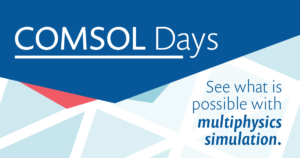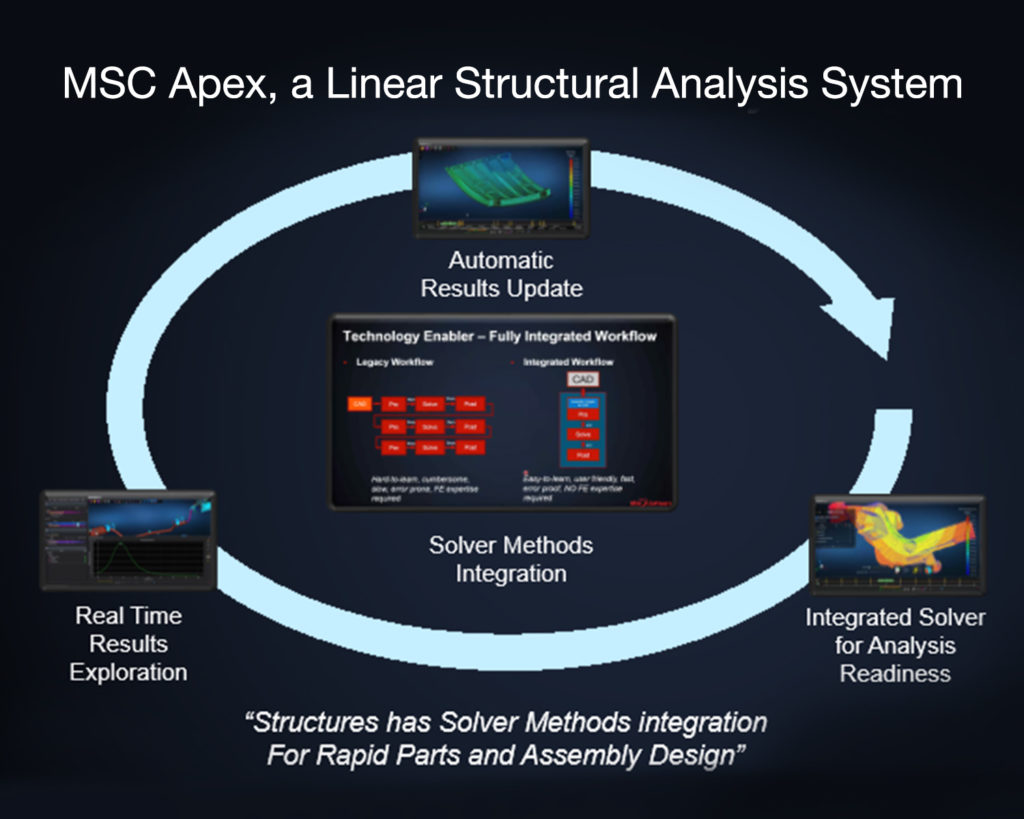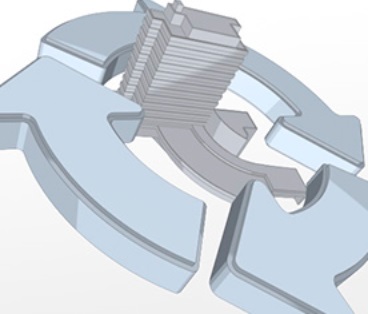 COMSOL is excited to announce COMSOL Days 2021. These 1-day virtual events feature live technical presentations, keynote talks from invited speakers, and panel discussions focused on using multiphysics modeling and simulation to accelerate product development and advance research. Parallel tracks cover the latest news in COMSOL Multiphysics and include sessions for attendees who are looking to understand how simulation, and the creation and deployment of specialized apps, can benefit their organization. In interactive Tech Cafés on specialized topics, COMSOL application engineers and technical product managers will share modeling best practices and field questions from COMSOL users and attendees on their simulation projects. COMSOL Day attendance is free of charge.
COMSOL is excited to announce COMSOL Days 2021. These 1-day virtual events feature live technical presentations, keynote talks from invited speakers, and panel discussions focused on using multiphysics modeling and simulation to accelerate product development and advance research. Parallel tracks cover the latest news in COMSOL Multiphysics and include sessions for attendees who are looking to understand how simulation, and the creation and deployment of specialized apps, can benefit their organization. In interactive Tech Cafés on specialized topics, COMSOL application engineers and technical product managers will share modeling best practices and field questions from COMSOL users and attendees on their simulation projects. COMSOL Day attendance is free of charge.
Jeanette Littmarck, sales director at COMSOL and project leader for COMSOL Days, says: “We have found that the online format is convenient and efficient for many, and we are really happy about the activity level at these events. Attendees are participating in discussions, and ask a lot of great questions. And according to attendee feedback, COMSOL Days are providing the great experience that we strive to provide.”
More than 40 online COMSOL Day events are planned for 2021 and cover a wide range of application areas, including:
- Engineering education and research
- MEMS
- Batteries
- Optics and photonics
- Biomedical applications
- Acoustics
- Vehicle electrification
- AC/DC
- Heat transfer in material processing
A number of COMSOL Days cater to a geographic region, with guest speakers from the local simulation community. One example is COMSOL Day Canada, where COMSOL is teaming up with CMC Microsystems. CMC manages Canada’s National Design Network and makes the COMSOL software easily accessible to researchers in their network. Owain Jones, CAD manager at CMC and guest speaker at COMSOL Day Canada, said, “Cohosting this event is a great way for COMSOL and CMC to service the Canadian microsystems R&D community. Our members can connect with both CMC and COMSOL, ask questions, and learn about topics that are relevant to their work.”
Events that are open for registration are listed here: COMSOL Days 2021. The list of events will be updated throughout the year.
COMSOL
www.comsol.com

 Verisurf Software, Inc. has announced the availability of its Quality Inspection Suite, a combination of popular Verisurf application modules configured to provide an efficient quality inspection and reporting solution. Quality Inspection Suite provides a cost-effective package and flexible purchase options to match the needs of individual customers, including site license and subscription options.
Verisurf Software, Inc. has announced the availability of its Quality Inspection Suite, a combination of popular Verisurf application modules configured to provide an efficient quality inspection and reporting solution. Quality Inspection Suite provides a cost-effective package and flexible purchase options to match the needs of individual customers, including site license and subscription options. Hexagon AB, a global provider of information technologies that drive productivity and quality across geospatial and industrial enterprise applications, today announced the completion of the previously announced acquisition of MSC Software (“MSC”), a US-based leading provider of computer-aided engineering (CAE) solutions, including simulation software for virtual product and manufacturing process development. Completion of the transaction was subject to regulatory approvals and other customary conditions, which have now been obtained.
Hexagon AB, a global provider of information technologies that drive productivity and quality across geospatial and industrial enterprise applications, today announced the completion of the previously announced acquisition of MSC Software (“MSC”), a US-based leading provider of computer-aided engineering (CAE) solutions, including simulation software for virtual product and manufacturing process development. Completion of the transaction was subject to regulatory approvals and other customary conditions, which have now been obtained. Dassault Systèmes, the 3DEXPERIENCE Company, today announced that the Procter & Gamble Company (P&G), one of the world’s largest consumer packaged goods companies, is using the 3DEXPERIENCE platform. P&G is deploying Dassault Systèmes’ “Perfect Product” and “Perfect Package” industry solution experiences to connect thousands of users to data, colleagues and consumers. This accelerates and improves the company’s packaging and product design, requirements management and program management.
Dassault Systèmes, the 3DEXPERIENCE Company, today announced that the Procter & Gamble Company (P&G), one of the world’s largest consumer packaged goods companies, is using the 3DEXPERIENCE platform. P&G is deploying Dassault Systèmes’ “Perfect Product” and “Perfect Package” industry solution experiences to connect thousands of users to data, colleagues and consumers. This accelerates and improves the company’s packaging and product design, requirements management and program management. COMSOL Inc. has announced the latest release of the COMSOL Multiphysics and COMSOL Server simulation software.
COMSOL Inc. has announced the latest release of the COMSOL Multiphysics and COMSOL Server simulation software.





 Siemens introduces Catchbook software, a new drawing and tracing app for tablets and smartphones that converts freehand drawings into accurate 2D designs. The new app provides a simple and intuitive user interface that works with both touch and stylus enabled Android, iOS and Windows operating system devices. Catchbook was designed to be a digital version of the proverbial napkin sketch, the birthplace of many amazing inventions – and even more home remodeling projects. Catchbook can be used to simply sketch ideas, just as one would do using pencil and paper, yet it’s smart enough to create precise, to-scale drawings that can be used for planning and construction. Even better, the drawings are completely editable via simple push and pull, making Catchbook far more powerful than any piece of paper. Developed by Siemens’ product lifecycle management (PLM) software business,
Siemens introduces Catchbook software, a new drawing and tracing app for tablets and smartphones that converts freehand drawings into accurate 2D designs. The new app provides a simple and intuitive user interface that works with both touch and stylus enabled Android, iOS and Windows operating system devices. Catchbook was designed to be a digital version of the proverbial napkin sketch, the birthplace of many amazing inventions – and even more home remodeling projects. Catchbook can be used to simply sketch ideas, just as one would do using pencil and paper, yet it’s smart enough to create precise, to-scale drawings that can be used for planning and construction. Even better, the drawings are completely editable via simple push and pull, making Catchbook far more powerful than any piece of paper. Developed by Siemens’ product lifecycle management (PLM) software business,